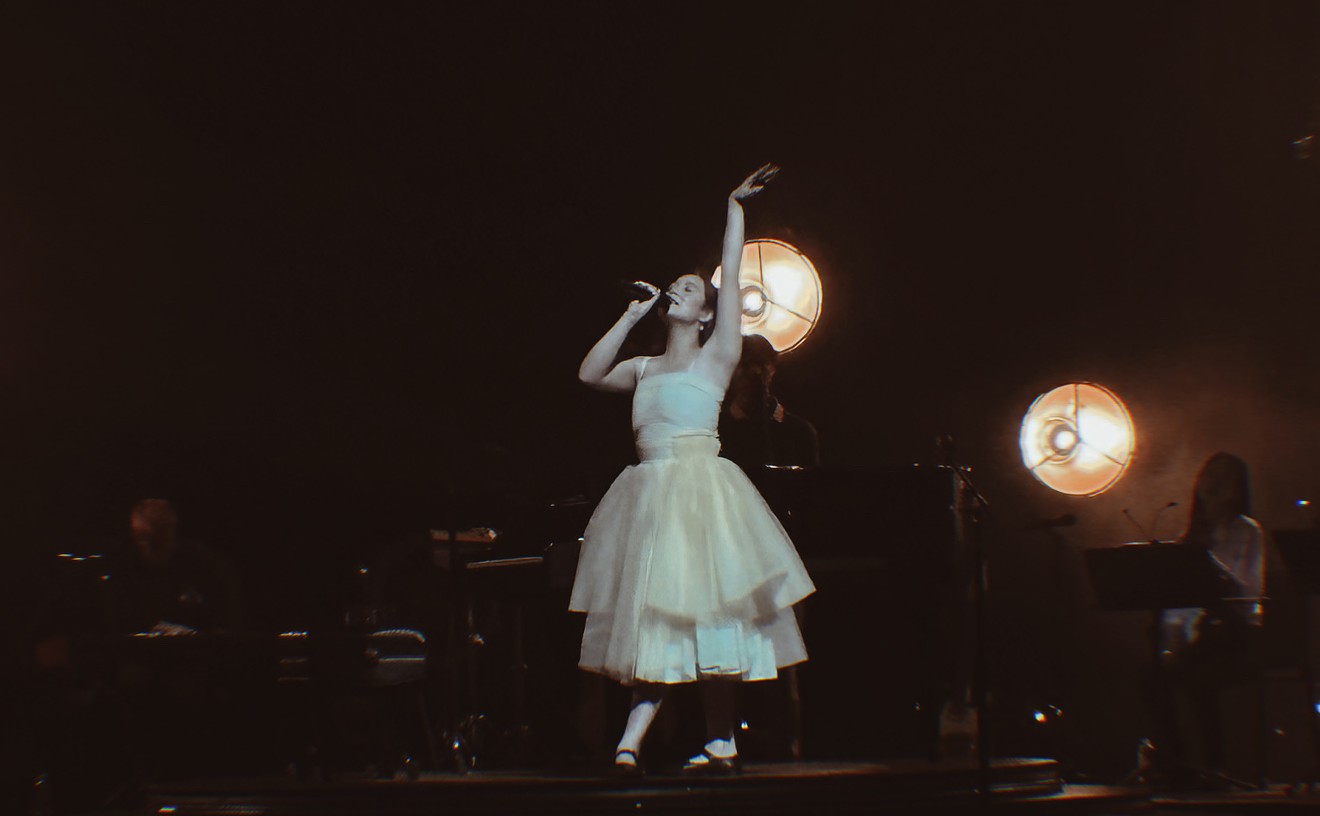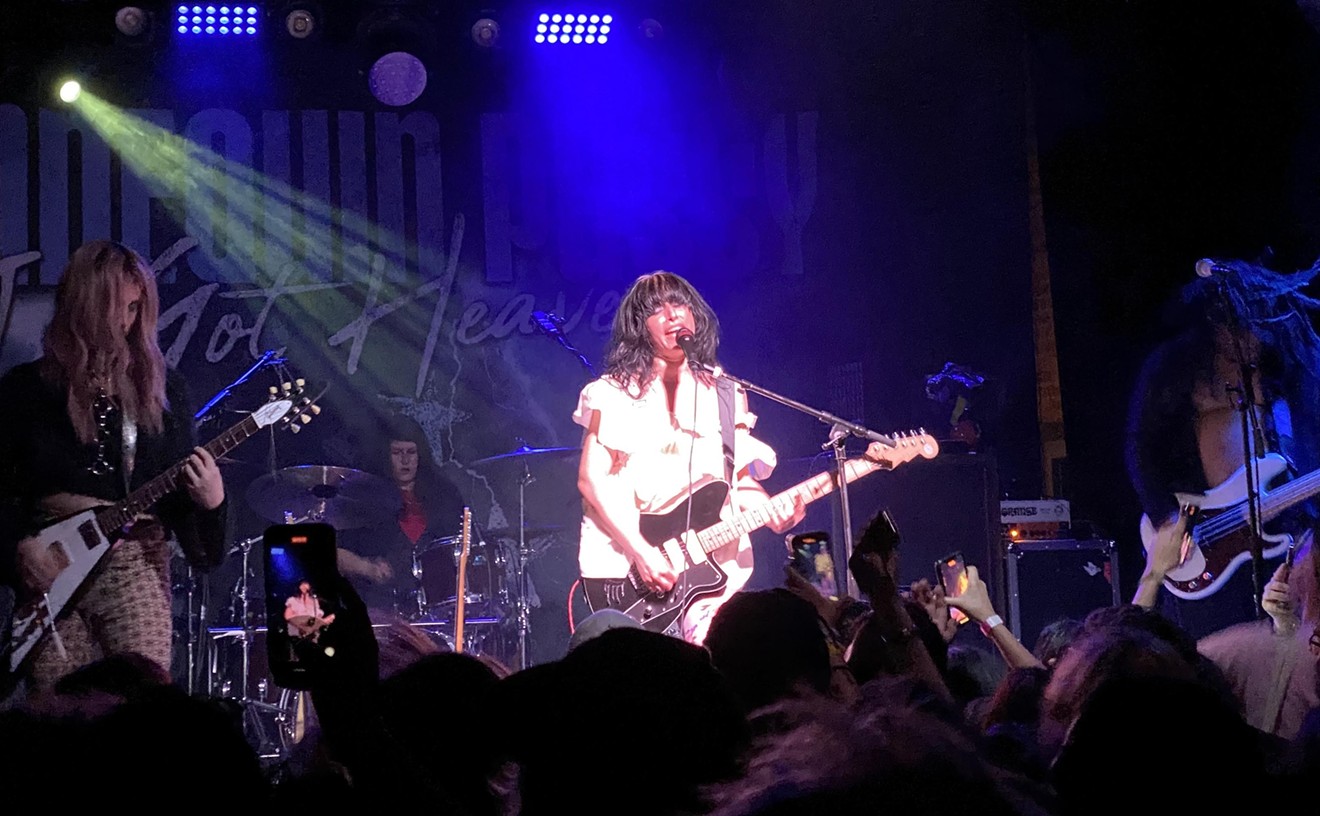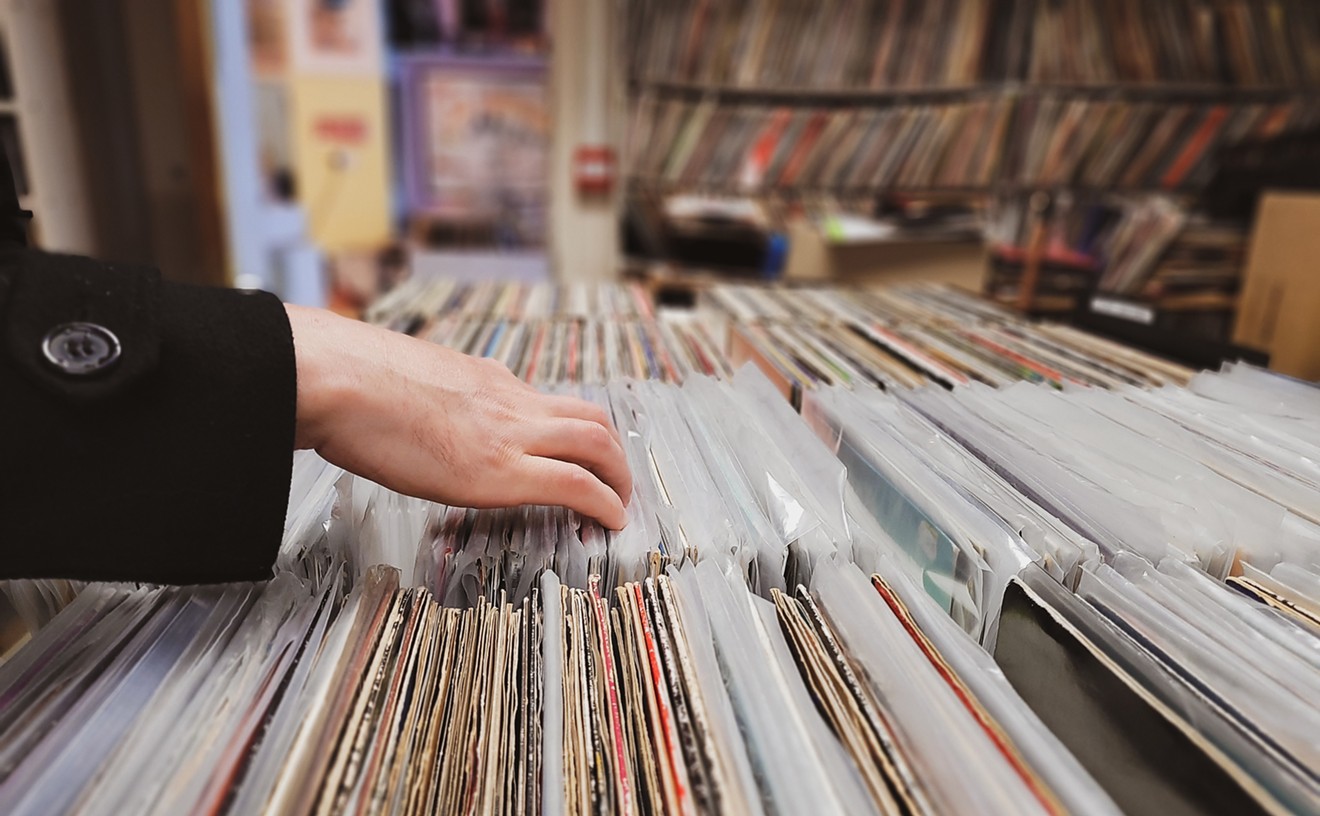By the time he got around to telling the story of jazz--"America's music," as the promotional materials remind again and again--Burns had stopped making promises and predictions. He would take as much time as he needed, and there would be little argument from PBS or sponsor General Motors or the Corporation for Public Broadcasting or anyone else. As a result, Jazz will be his longest film yet: 19 hours, spread over 10 episodes that begin airing January 8 on KERA-Channel 13. For some, Jazz--the final installment in Burns' so-called "American Trilogy," though it didn't begin that way--might not feel long enough. It's a Louis Armstrong scat, an Ella Fitzgerald ballad, a Miles Davis growl, a Billie Holiday moan, a John Coltrane prayer, a Count Basie bomp, a Thelonious Monk bang on the piano keys. It is, quite simply, the song that cuts out while you're still swinging, stomping, and sing, sing, singing.
And so Burns goes on and on about it, insisting over and over again that Jazz is his best film yet--that "it represents a quantum leap as a filmmaker in terms of solving the problems of taking something that's normally background--music--and making it foreground." His is a most eloquent and passionate monologue; Burns, for the moment, is jazz's most fervent disciple, a born-again acolyte preaching the gospel into any tape recorder within sight. That is why he has done so many interviews in the months leading up to the film's debut on PBS: He likens it to a political campaign, spreading the word until even the skeptics will feel the need to go to the television and cast their vote for Charlie Parker or Louis Armstrong or Sarah Vaughan.
To that end, he has also gotten out the word early by releasing this month a mammoth, marvelous companion book, Jazz: A History of America's Music, co-written by Burns and Geoffrey Ward; a five-disc boxed set, Ken Burns Jazz, featuring 94 songs culled from the nearly 500 pieces of music used in the series; a single-disc best-of; and 22 compilations featuring, individually, Duke Ellington, Ornette Coleman, Charlie Parker, Fletcher Henderson, Benny Goodman, and 17 other pioneers featured in the documentary. Featuring contributions from all of jazz's major and minor labels, thanks to a truce between normally warring labels Sony and Verve, the boxed set is the closest jazz has had to an essential primer since the 1987 five-disc Smithsonian Collection of Classic Jazz boxed set went out of print.
"Jazz used to be America's music, and now it's given birth to all these other forms like rock and R&B and soul and hip-hop, and people sort of think of it as anachronistic," Burns says of the reason he insisted on the release of the 28 CDs. "But they also know there's a huge bunch of people they're curious about and interested in who seem to love jazz, and they're sort of worried they should get hip with it, but it seems like you have to have an advanced degree to understand it. Well, I just spent six years proving that it ain't homework. The only thing you need is the ability to tap your foot if you hear something you like, and that's what we've done."
Yet, by his own admission, Burns knew little of the subject when he began working on the film six years ago. He had but a handful of jazz albums in his mammoth record collection, despite spending his youth working in a record store. There were so few records, he can tell you exactly which ones they were: John Coltrane's A Love Supreme, Miles Davis' Kind of Blue, a couple of Duke Ellington discs, some albums by 1930s big-band leader Ray Noble, Shelly Manne's 1956 album featuring songs from My Fair Lady, and 1963's Getz/Gilberto. It was the sort of collection one inherits from a grandmother who, long ago, gave up trying to be hep.
To hear Burns tell it, he had little interest in making a film on the subject until working on his Emmy Award-winning Baseball series, which drew 45 million viewers to PBS during its run in 1994. While filming Baseball, he began to realize that if the Civil War was the defining moment in all of American history, then baseball--the most immutable of America's pastimes, nearly unchanged since its inception--somehow defined the country after the war. After all, in Baseball he could use the sport as a foundation upon which he could build a much bigger story, one about race, immigration, assimilation, the growth and decay of cities, the nature of heroes and villains and fools, the rise of popular culture, the birth of advertising, and the struggles between management and labor--to begin with. He was no romantic in love with the sound of the crack of a bat, no sentimentalist enamored of the smell of leather and freshly mowed grass. He was, instead, the self-proclaimed "emotional archeologist" digging up black-and-white yesterdays to reveal America as it is today.
When he was working on the prologue to the first episode, an eight-minute introduction, writer Gerald Early offered a comment that stuck with Burns and, in the end, led to what would become his next project. Early noted that when archeologists study our civilization 2,000 years from now, this country will be known for only three things: the Constitution, baseball, and jazz--"the three most beautiful things America's ever produced," Burns repeats. Using jazz as his, well, instrument, the filmmaker could riff even further on Baseball's themes; suddenly, he realized he had the makings of a sequel.
"Gerald's quote tends to put a smile on the face of the listener or reader, but he's right," Burns says from his offices in New Hampshire. "Our genius is for improvisation, and I intellectually thought, 'Well, I should think about jazz.' I didn't know much about it. I ran a record store when I was in high school and sorta knew a lot about it, but hadn't taken it into my heart. I was a child of rock and roll. And I'd met Wynton Marsalis a few years before. He'd heard me give a speech about the Civil War, and he came up to me and said, 'Man, you should do jazz,' and I went, 'Yeah, yeah, yeah.' No one likes to be told what to do, but all of a sudden here's Gerald Early ratifying that the three great things are the Constitution, whose greatest test, of course, was the Civil War; baseball, which I was then in the middle of working on; and this thing called jazz, which I know almost nothing about, just as I had known nothing about the Civil War and baseball.
"And then, the central episodes of Baseball--the '20s, the '30s, the '40s--had jazz as its background. I was putting jazz in them, and it was working: Count Basie and Lester Young's 'Tickle Toe' over Babe Ruth's called shot. And I finally said, 'That's it--I'm not working on a sequel, I'm working on a trilogy, and I have to turn to jazz.' Baseball was released in the fall of 1994, and six and a half years later, here's Jazz. And ya know what? It really carries on the story. They're so totally related to each other. The central fault line of race is there, and Jazz continues this American narrative, which is really about the 20th century as much as it's about this music. And at the same time, it offers some kind of glimpse into some possibilities for us, I think. At least for me, it's been curative."
Art, Tolstoy once said, is the transfer of emotion from one person to another, and Burns' enthusiasm for his subject is indeed contagious. If the music is in a period of stagnancy--if all we're left with are shadows of legends, young men mimicking the cracks and pops of old acetate recordings polished and sanitized for the digital age--then Burns reminds us not only of the music's vibrancy but of its relevance. The film, book, and boxed set let us inside the music in such a way that we understand what a wordless melody really says, really means. Jazz shines a light into hidden corners of history, where only scholars and critics hang out to discuss Lester Young and Coleman Hawkins and Mary Lou Williams, and it makes mortal those men and women who have been enshrined and entombed in history books for so long that their contributions to culture have been shrouded by the dust of apathy.
Burns, who despises historians who soak their works in the tears of sentimentality and nostalgia, makes no attempt to hide the fact that his film has its own set of heroes. It deals extensively with Armstrong, Parker, Davis, Coltrane, Ellington, and Dizzy Gillespie, building Burns' narrative around theirs as they evolve from young men learning their way around their instruments to giants who would create the soundtrack for the 20th century. The film actually ends with Armstrong's death in 1971 and Ellington's demise three years later; and Burns spends a single hour wrapping up the subsequent 30 years of history. He's already heard plenty of criticism from those jazz fanatics who want to know why he pays so little attention to modern-day practitioners. "And I say to them, 'So you tell me, among the people playing now or anyone alive in jazz, who is the equal of Armstrong, Ellington, Parker, Davis, or Coltrane?'" he says. "Complete silence. I said, 'I have made my point.'"
Indeed, there are those among the jazzerati who believe the marathon film--and Burns does like to think of Jazz as a single piece of work, divided into chapters as though it were a sweeping novel--is incomplete, insufficient. Though its premiere is still two months away, the self-appointed gatekeepers of jazz have already descended upon Burns to let him know, in no uncertain terms, that he's ill-informed at best about the history of the music and plain ignorant at worst.
"I can only assume that you are getting some very poor advice and serious misinformation," wrote concert and album producer Marty Khan on one jazz-freak Web site, www.birdlives.com. Khan's missive was presented as an open letter to Burns, and in it, he griped to the filmmaker about the fact that he left out of Jazz any substantive reference to pianist-composer George Russell, whose polytonal compositions "profoundly influenced many of our greatest jazz artists," Khan insists, "including John Coltrane, Miles Davis, Charlie Parker, Dizzy Gillespie, Ornette Coleman, etcetera." Russell, incidentally, was a white man, but Burns also leaves out Erroll Garner, pianist and composer of the beloved "Misty." A section on Garner was filmed but excised, simply because, as Burns insists, he's "not in the same league" as the aforementioned giants.
In his letter, Khan suggests that Russell is missing from the documentary because Burns has relied too heavily on the suggestions of Wynton Marsalis, who, indeed, is all over the film and receives his own six-page question-and-answer section in its companion book. Marsalis (and critic Stanley Crouch, one of Marsalis' confidants and another highly visible figure in Jazz) has been the fault line in the jazz community, such as it is, ever since he took command of Jazz at Lincoln Center in the early '90s. New York critics insisted then, and now, that Marsalis' choice of programs, nearly all of which have focused on black composers, were and remain "racist," in the words of New York Times critic Peter Watrous in 1994. They dog him for being arrogant, aloof, and a man who stares forever backward without ever moving forward; that he idolizes Ellington and Armstrong without ever mentioning Bix Beiderbecke or George Russell infuriates them even further. And they lob at him the most damning complaint of all: He's nothing but a rip-off artist, covering old standards like a tepid bar-band playing for drink tickets on a Tuesday night. Critics such as Eric Nisenson, author of 1998's Blue: The Murder of Jazz, curse Marsalis for his obsession with the past.
Burns knew that by hooking up with Marsalis, he was asking for hell; he knows how much of a "lightning rod" Marsalis is, just as he knew that he would never gather together in a single room the myriad advisors he called upon to assist him with Jazz. (The list includes such critics, historians, archivists, and educators as Crouch, Gary Giddins, Gunther Schuller, Loren Schoenberg, and James Lincoln Collier.) "We couldn't have assembled them in the same room, because a fistfight would have broken out," Burns says, sort of chuckling. "They wouldn't be able to agree on the shape of the table." But he could not have cared less about old feuds and ideological differences; his was not going to be a thesis, but a tale, and those interviewed for and consulted about the film were not allowed to offer theories or make accusations. They were brought aboard for very simple reasons: to tell stories and bring to life the ghosts of great men and women who are not around to speak for themselves.
"If you look at the film, there's not a single philosophical tract that these guys get away with," Burns says. "They're just telling stories, which is all I'm interested in doing, and that's the great saving grace of history--finally, at the end, God is the greatest dramatist. Shelby [Foote] wrote me a letter about that. He said, 'Think about it. This guy [Abraham Lincoln] gives up his entire professional life to save the Union, he finally saves the Union on the ninth of April, and five days later, he decides he's got enough free time to go to the theater. God is the greatest dramatist.' He's basically saying, don't try to manipulate it; just tell what happened one step after another, and this is true in jazz. Wynton Marsalis is terrific not because he's got a particular philosophy, but because he can make the Count Basie Band come alive and play every instrument or, at the end of the first episode, he can pause with a poignancy and try to deal with this question of race not only as a great musician who knows the history of jazz, but as a black man. It's an amazing moment in the film.
"The jazz community has turned itself into Pigpen from Peanuts. They're arguing all the time: 'Well, Wynton said this, and you're on Wynton's side.' You get all this argument, and this cloud of dust surrounds it. I'm trying to reach some little old lady in Dubuque who thinks Lawrence Welk is the bee's knees, and I want to remind her that Lawrence Welk is only in existence because there was this thing before him called jazz, and if you listen to this, you will find the pulse and the meaning of America in this music."
In The Civil War, Burns rendered flesh the specter of Abraham Lincoln; in Baseball, he found the sport's soul in Jackie Robinson. No figure looms more significantly over Jazz than Louis Armstrong. Burns refers to him repeatedly as the most significant musical figure in all of American history, and his panel of consultants never once argued with his assertion, to Burns' surprise and delight. Before he began working on the film, Burns thought of Armstrong as most Americans do: as a grinning, hankie-waving crowd-pleaser who sang "Hello, Dolly!" and "What a Wonderful World" "with one foot in minstrelsy," he explains. Soon enough, Burns was set straight by musicians and the music itself: Armstrong turned jazz into a soloist's art, changed the way musicians played their instruments, and transformed the way singers performed popular songs. In the book, Wynton Marsalis explains Armstrong as a man who possessed both "the deepest human feeling and the highest level of musical sophistication." For Burns, the revelation was startling.
That is why he decided to begin the boxed set, the series, and even the book with Armstrong's rendition of Hoagy Carmichael's "Stardust." It is not the oldest song used in Jazz--it was recorded in 1931, 14 years after the Original Dixieland Jazz Band cut "Livery Stable Blues"--but it is, in some ways, the most significant. And Burns is dying to explain why.
"When you talk about Louis Armstrong, you end up dealing with somebody who has this spiritual dimension," he says in a hushed, reverential tone of voice. "Grown men would start to cry in the interview talking about Armstrong. In the fourth episode, there's a section called 'Mr. Armstrong,' which talks about a guy named Charles Black. In September of 1931, Charles Black was a 16-year-old in Austin, Texas, looking for girls. He didn't like jazz, had never heard of Armstrong, and all of a sudden, he walks into this room at the Driskill Hotel, stops dead in his tracks, listens to Armstrong riffing on 'Stardust,' and he realizes he's seeing genius for the first time.
"He realizes this is the American genius. He realizes that all his life he's been taught black people aren't worth shit. After that, Charlie Black goes on to get a law degree and works with Thurgood Marshall to convince the Supreme Court in Brown vs. the Board of Education of Topeka that segregating schoolchildren on the basis of race and skin color is unconstitutional. That's unbelievable to me. We used to argue in film class: Can people make a difference? Do films make a difference? I've got proof that both films and people do all the time."










